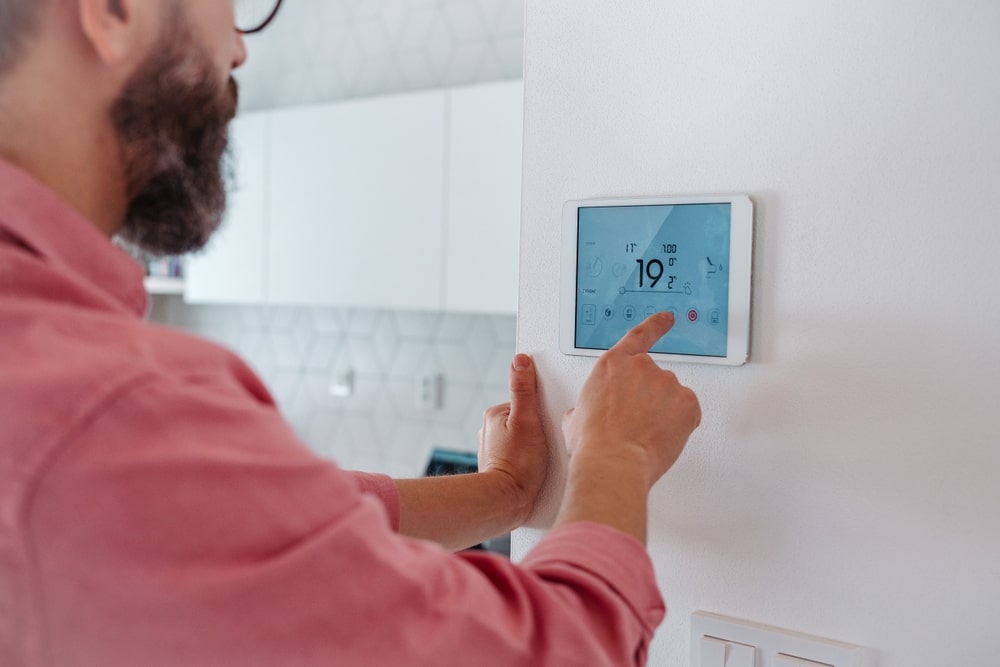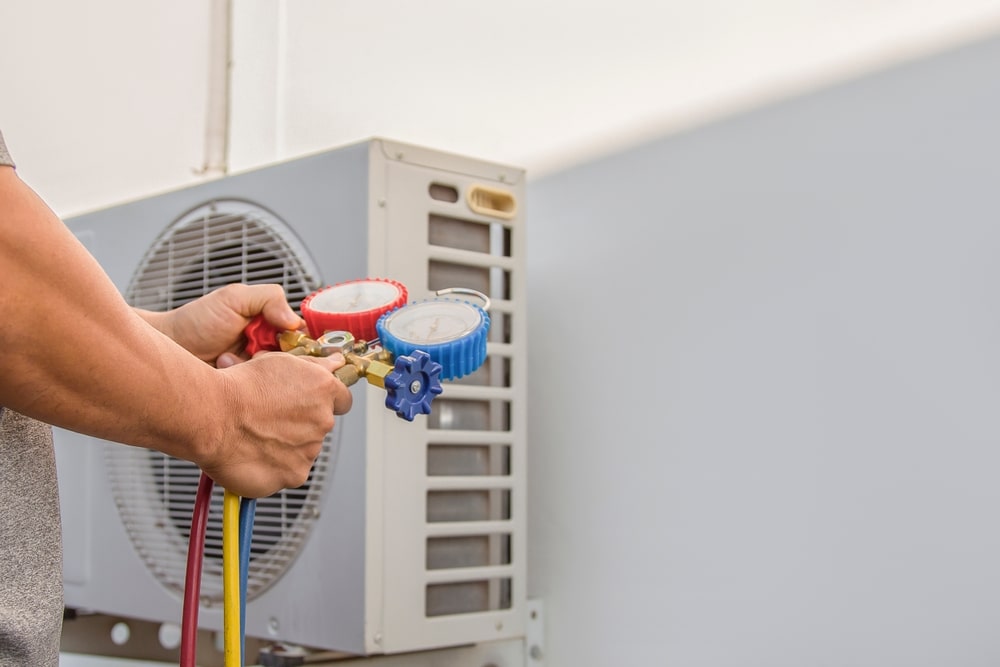Table of Contents
If you think your home’s air is clean, you may want to think again. Many Calgary homeowners are surprised to learn that indoor air can be 2–5 times MORE polluted than what’s outside (shocking, we know!). From itty-bitty invisible allergens to chemical residue circulating, there’s a lot happening in the air you breathe every day and more than you may realize. That’s where home indoor air quality testing comes in.
Whether you’re worried about asthma triggers, pet dander, nasty mold, or just want to simply breathe easier, understanding how it works and improving your home’s air quality is a game-changer!
We at The Heating Ninja are here to guide you through the stealthy world of air quality detection (no black belt required) so that you, your loved ones and/or your furry friends can all rest easy, knowing you can breathe easy.
Calgary winters might keep us indoors longer (than we may like), but your air doesn’t have to feel stale, and your health will benefit greatly.
Let’s break down the simple ways you can test your home’s indoor air quality and share with you our pro tips to improve it without overhauling your entire HVAC system.
First of all – What Is Indoor Air Quality (IAQ), Really?
IAQ stands for Indoor Air Quality, and it’s exactly what it sounds like: how clean, pure, breathable, and healthy the air in your home is. Plain and simple. The usual suspects that can tank your IAQ include:
- Dust and pet dander
- Mold and mildew (it’s as gross as it sounds)
- Volatile Organic Compounds (VOCs) from paint, furniture, and cleaning supplies (which most people overlook)
- Carbon monoxide and radon (a naturally occurring radioactive gas produced from the decay of uranium in soil and rock)
- Poor ventilation
If you or someone in your home often experiences symptoms like respiratory issues, sneezing, headaches, fatigue, or allergies, your indoor air might be the culprit.
Why Home Indoor Air Quality Testing Matters
Home indoor air quality testing gives you the real answers. It tells you:
- What pollutants are floating around your home
- Whether your HVAC system is helping or hurting your home environment
- If it’s time to invest in purification, maintenance or ventilation upgrades
This is especially important for Calgary residents to know. Due to Calgary’s long and often extreme winter conditions, opening windows isn’t always practical (especially when it’s -30 below with wind chill). So, knowing what’s in your air is the first step to fixing it.
How to Test the Air in Your Home (Like a Ninja)
You don’t need to be a mad scientist – or a heating ninja – to start home indoor air quality testing.
Here’s how you can test the air quality in your home on your own:
- Use an Indoor Air Quality Monitor
These handy dandy gadgets test for PM2.5 (fine particles), VOCs, humidity, and more. Some even give you real-time readings and connect to your phone for an easy user experience. - Test for Carbon Monoxide
Every home should have an active working CO detector, especially if you use gas appliances or a furnace. Carbon monoxide is an invisible gas, but incredibly dangerous, and can be lethal if there’s a leak. - Try a DIY Mold Test Kit
Notice a strange, musty smell? A DIY mold test can confirm whether mold spores are circulating in your air and causing you grief. - Schedule Professional Testing
Not sure what’s lurking in your air or where to start? Time to call in the pros! With a licensed HVAC technician at your side, you’ll get a detailed home indoor air quality test done and be provided with expert-recommended solutions tailored to your space.
Don’t Hold Your Breath: Additional Ways to Improve Your Indoor Air Quality
Once you know what you’re dealing with, it’s time to fight back:
- Upgrade Your Air Filters
Swap out any cheap filters for expert-recommended alternatives and set a reminder in your calendar to replace them every 1-3 months. Better to go with the best form the start! - Add Houseplants (The Right Ones)
Houseplants like spider plants, peace lilies, and snake plants can give your home a natural boost in air filtration – they’re nature’s little leafy air purifiers. But while your green friends are doing their part, don’t forget the heavy lifters: your HVAC system and air filters. Regular maintenance ensures your air stays clean, safe, and fresh, beyond what your botanical buddies can handle alone. - Use Natural Cleaning Products
Avoid cleaners with harsh chemicals. Choose eco-friendly, unscented, low-VOC products to reduce chemical build-up in the air. The chemical-laden residue from most cleaning products can create a problem for your overall air quality and respiratory health down the road. - Install an Air Purifier
A good ‘ol reliable purifier with a HEPA filter can significantly reduce allergens, smoke, and odours in your home, and can be especially helpful during wildfire season when more smoke is present than usual. - Keep Humidity in Check
Too much moisture in your home = mold (yuck). Too little = dry skin and irritated sinuses (not fun). If there’s condensation buildup or foggy windows or mirrors, and damp walls in your home consistently, your humidity levels are too high, which over time, can make your home more prone to mold buildup. Make sure your home’s humidity level is balanced for better air quality and overall health. Having a dehumidifier is also a helpful option! - Maintain Your HVAC System
Have your home HVAC system cleaned, maintained and inspected at least once a year. Better airflow + better air quality = better health overall for you and your loved ones.
When to Call in The Heating Ninja
If your air still smells off or you’re not seeing improvements after your DIY efforts, don’t fret, dear friends – we’ve got your back! From installing air purifiers, maintaining your HVAC system and providing high-efficiency filtration, we’ll help you breathe easier – no shoddy guesswork, no goofy gimmicks.
Ready to finally breathe easier?
Book your desired servicer with us today, and we’ll clean your air, The Heating Ninja way!
Frequently Asked Questions
How do I know if my indoor air quality is poor?
Answer: Some common tell-tale signs that your air quality is less than optimal include: frequent sneezing, headaches, fatigue, dry or irritated eyes, consistent respiratory issues, and worsening allergy or asthma symptoms, especially when you spend a lot of time indoors. You may also notice musty odours around your home, condensation on your windows, or visible mold. If something “feels off” in your space, it’s worth testing your air quality to ensure you’re breathing in clean and pure air.
What’s the best way to test my home’s air quality?
Answer: You can start with a home indoor air quality monitor, which measures pollutants like VOCs (Volatile Organic Compounds – chemicals that easily become vapours or gases and are released from certain solids or liquids – often found in everyday household items, like cleaners) and PM2.5 (fine particles) in real time.
You can also use carbon monoxide detectors and DIY mold test kits. However, for a full assessment and some peace of mind, consider booking a professional HVAC technician for a comprehensive IAQ test.
Can houseplants really help improve indoor air?
Answer: Yes – and no. While plants like spider plants and peace lilies can help absorb certain toxins, they’re not powerful enough on their own to purify the air of your entire home. Think of them as your leafy green sidekicks. The real air-quality ninjas are regular filter changes, proper ventilation, and a professionally well-maintained HVAC system.
How often should I change my air filter?
Answer: It depends on your filter type, household size, and whether you have pets. A good rule of thumb is every 1-3 months. If you have any allergies or live in a high-dust environment (hello, Calgary winters), monthly filter changes are definitely ideal for optimal performance and overall health.
What can I do if I’ve tried everything and the air still feels bad?
Answer: Call in The Heating Ninja! Sometimes, poor air quality is tied to underlying issues like duct contamination, improper humidity, or an aging HVAC system – things the average homeowner can’t DIY their way out of. Here at The Heating Ninja, we’ll diagnose the problem and recommend solutions that actually work to ensure your indoor air quality is clean and safe – no guesswork, no gimmicks.
Contact us today to book a service!



